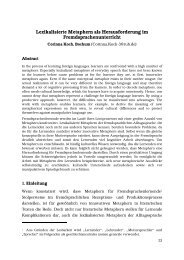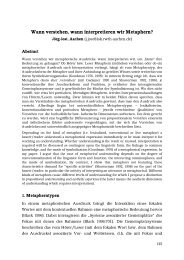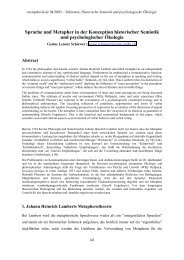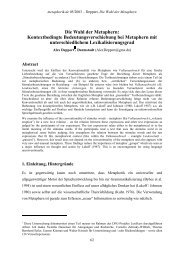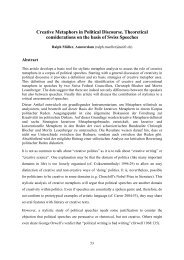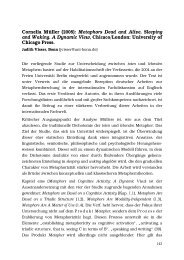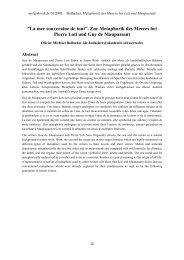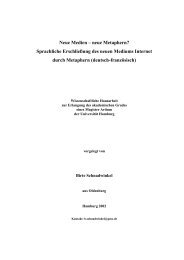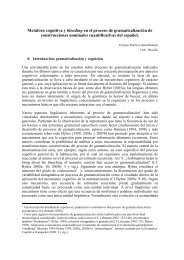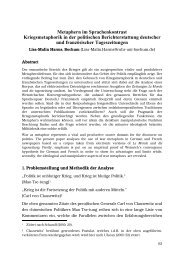Hans Erich Bödeker - metaphorik.de
Hans Erich Bödeker - metaphorik.de
Hans Erich Bödeker - metaphorik.de
You also want an ePaper? Increase the reach of your titles
YUMPU automatically turns print PDFs into web optimized ePapers that Google loves.
<strong>metaphorik</strong>.<strong>de</strong> 11/2006 – Rezensionen / Reviews / Comptes rendus<br />
concepts requires the reconstruction of complex networks of concepts (218). However, it is<br />
noteworthy that the analysis of concepts and metaphors seem to share some similarities:<br />
methodologically, it is striking that, throughout the book, both metaphorists and conceptual<br />
historians emphasise the importance of analysing the occurrences in their contexts. Moreover,<br />
both metaphorists and conceptual historians are interested in relating discourse to an extra-<br />
textual, social-historical context. These similarities suggest that the history of concepts and<br />
metaphors share at least some common methodological interests.<br />
In the light of these common methodological interests, it could be possible to <strong>de</strong>scribe a more<br />
inclusive relation between the history of concepts and the history of metaphors. For instance,<br />
Rüdiger Zill, who discusses <strong>Hans</strong> Blumenberg’s (1920-1996) historical programme of a<br />
“Metaphorologie”, proposes (with the help of Blumenberg and Kant) a symbiotic relationship<br />
between metaphor and concepts, since metaphors may provi<strong>de</strong> in many cases the intuition<br />
(“Anschauung”) to highly complex and almost inconceivable concepts (e.g. “world”; 229).<br />
However, the history of metaphor is mostly treated as a project that is more or less<br />
in<strong>de</strong>pen<strong>de</strong>nt from the history of concepts. Conceptual historians do not propose particular<br />
methodologies for <strong>de</strong>aling with metaphors, and the metaphorists do not integrate the history<br />
of metaphor in conceptual history.<br />
As a result, we have to content ourselves with sketchy comments on what a combination of<br />
history and metaphor analysis may look like. Zill suggests a reformulation of Blumenberg’s<br />
metaphorology in terms of a cultural history that investigates the everyday experience upon<br />
which metaphors rest (252). This potential is exemplified by Blumenberg’s studies on “truth<br />
metaphors”, in particular with the paradigmatic shift during the Renaissance, when truth was<br />
no longer perceived as a self-imposing force, but something that has to be acquired by hard<br />
work. Zill points out that Blumenberg ma<strong>de</strong> very little social-historical observations to<br />
explain such shifts, and he sees a future direction of research in the combination of<br />
metaphorology and a history of experience (254-258).<br />
Danneberg, an erudite practitioner of the historical analysis of metaphors, seems to be less<br />
prone to propose a particular programme of historical metaphor research. He spots problems<br />
in the i<strong>de</strong>ntification of metaphors and the analysis of single occurrences in terms of<br />
metaphorical systems and their hierarchy (405-413). Moreover, his (careful) consi<strong>de</strong>rations<br />
about the mutual relationship between social systems and metaphors (413-418) take him to<br />
the conclusion that a history of metaphor cannot be self-sufficient (421).<br />
In summary, this volume provi<strong>de</strong>s a lot of insight into theoretical and methodological issues<br />
in the historical analysis of fundamental concepts and metaphors. However, the contributions<br />
135





